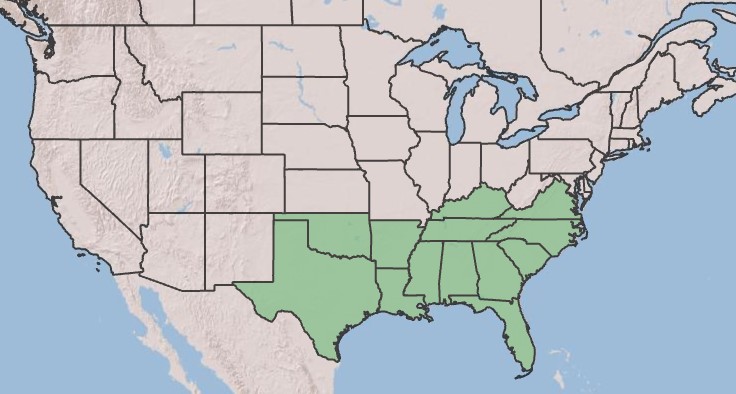Difference between revisions of "Eupatorium compositifolium"
(→Taxonomic Notes) |
ParkerRoth (talk | contribs) (→Description) |
||
| (4 intermediate revisions by one other user not shown) | |||
| Line 25: | Line 25: | ||
==Description== | ==Description== | ||
<!-- Basic life history facts such as annual/perennial, monoecious/dioecious, root morphology, seed type, etc. --> | <!-- Basic life history facts such as annual/perennial, monoecious/dioecious, root morphology, seed type, etc. --> | ||
| + | |||
| + | According to Diaz-Torbio and Putz (2021), ''Eupatorium compositifolium'' has rhizomes with a below-ground to above-ground biomass ratio of 1.97 and nonstructural carbohydrate concentration of 57.6 mg g<sup>-1</sup>.<ref>Diaz‐Toribio, M. H. and F. E. Putz. 2021. Underground carbohydrate stores and storage organs in fire‐maintained longleaf pine savannas in Florida, USA. American Journal of Botany 108(3):432-442.</ref> | ||
==Distribution== | ==Distribution== | ||
==Ecology== | ==Ecology== | ||
| − | + | ===Habitat=== | |
| + | ''E. compositifolium'' occurs in dry, open areas of natural communities such as pine flatwoods, pine-palmetto flatwoods, turkey oak-longleaf pine sand ridges, and sand scrubs. It can also be found in old fields, slash pine plantations, and along roadsides and railroads. ''E. compositifolium'' grows in well drained sandy clay and loamy sand.<ref name = fsu> Florida State University Robert K. Godfrey Herbarium database. URL: http://herbarium.bio.fsu.edu. Last accessed: May 2023. Collectors: Loran C. Anderson, Wilson Baker, William B. Fox, J. P. Gillespie, R. K. Godfrey, Richard D. Houk, Holly Maurushat, and Richard S. Mitchell. States and counties: Florida: Alachua, Dixie, Franklin, Gadsden, Hamilton, Jackson, Leon, Marion, Putnam, Wakulla, and Walton.</ref> | ||
| + | |||
| + | Associated species of ''E. compositifolium'' include ''[[Eupatorium capillifolium]]'', ''[[Eupatorium semiserratum]]'', ''[[Quercus incana]]'', and ''[[Pinus taeda]]''.<ref name=fsu/> | ||
<!--===Phenology===--> <!--Timing off flowering, fruiting, seed dispersal, and environmental triggers. Cite PanFlora website if appropriate: http://www.gilnelson.com/PanFlora/ --> | <!--===Phenology===--> <!--Timing off flowering, fruiting, seed dispersal, and environmental triggers. Cite PanFlora website if appropriate: http://www.gilnelson.com/PanFlora/ --> | ||
<!--===Seed dispersal===--> | <!--===Seed dispersal===--> | ||
Latest revision as of 13:50, 3 July 2024
| Eupatorium compositifolium | |
|---|---|
| Scientific classification | |
| Kingdom: | Plantae |
| Division: | Magnoliophyta - Flowering plants |
| Class: | Magnoliopsida - Dicotyledons |
| Order: | Asterales |
| Family: | Asteraceae |
| Genus: | Eupatorium |
| Species: | E. compositifolium |
| Binomial name | |
| Eupatorium compositifolium Walter | |

| |
| Natural range of Eupatorium compositifolium from USDA NRCS [1]. | |
Common name: coastal dog-fennel, yankeeweed
Contents
Taxonomic Notes
Synonyms: none[1]
Varieties: none[1]
Description
According to Diaz-Torbio and Putz (2021), Eupatorium compositifolium has rhizomes with a below-ground to above-ground biomass ratio of 1.97 and nonstructural carbohydrate concentration of 57.6 mg g-1.[2]
Distribution
Ecology
Habitat
E. compositifolium occurs in dry, open areas of natural communities such as pine flatwoods, pine-palmetto flatwoods, turkey oak-longleaf pine sand ridges, and sand scrubs. It can also be found in old fields, slash pine plantations, and along roadsides and railroads. E. compositifolium grows in well drained sandy clay and loamy sand.[3]
Associated species of E. compositifolium include Eupatorium capillifolium, Eupatorium semiserratum, Quercus incana, and Pinus taeda.[3]
Conservation, cultivation, and restoration
Cultural use
Photo Gallery
References and notes
- ↑ 1.0 1.1 Weakley, A.S. 2020. Flora of the Southeastern United States. Edition of 20 October 2020. University of North Carolina at Chapel Hill, Chapel Hill, North Carolina.
- ↑ Diaz‐Toribio, M. H. and F. E. Putz. 2021. Underground carbohydrate stores and storage organs in fire‐maintained longleaf pine savannas in Florida, USA. American Journal of Botany 108(3):432-442.
- ↑ 3.0 3.1 Florida State University Robert K. Godfrey Herbarium database. URL: http://herbarium.bio.fsu.edu. Last accessed: May 2023. Collectors: Loran C. Anderson, Wilson Baker, William B. Fox, J. P. Gillespie, R. K. Godfrey, Richard D. Houk, Holly Maurushat, and Richard S. Mitchell. States and counties: Florida: Alachua, Dixie, Franklin, Gadsden, Hamilton, Jackson, Leon, Marion, Putnam, Wakulla, and Walton.